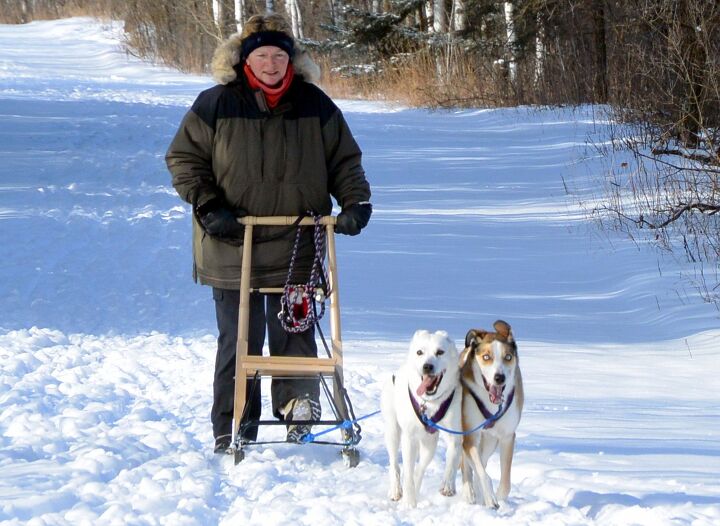The ABC’s of Kicksledding

A: A is for Addiction. Be warned that once you start kicksledding with your dog, it will be all you can think about. Ever.
B: B is for Brakes. Traditionally kicksleds do not require brakes. But traditionally kicksleds were not meant to be assisted with dog power! The most popular and safest breaks to add to a kicksled are drag matts, they sit up behind and under the stanchions. You step on them, and they allow you to slow your team.
C: C is for commands. Before you go, your dog will need to be trained in basic obedience and commands of mushing. Some dogs are naturals, while others take a season to really figure it out.
D: D is for dogs! Kicksleds are great to use for dogs 40 lbs and up, but we don’t advise using more than two dogs on a kicksled. Most any dog with a good build and a love of running will make an excellent kicksled companion.
E: E is for evenings. A magical time to run your dog is just as the sun is setting. Their primal instincts kick in and you will be in for the time of your life.
F: Is for fit. There is no better way to get fit than by exercising with your dog! Kicksleds are great cardio and strength training.
G: is for gangline. It’s the line that you use to attach the sled to the dog’s harness. We suggest using a longer gangline for kicksledding, this helps to alleviate pressure on the dog’s hips. A minimum of 8 feet, but people may use up to a 12-foot line. The longer the line, the more voice control you will need over your dog.
H: is for hills. Fun to ride down, hard to go up. Golden rules of hill; never overtake your dog going down a hill, and always get off the sled and push it going back up. It’s only fair!
I: I is for ice balls! Nasty things. Keep an eye on your dog’s feet to make sure you deal with the ice balls before they build up.
J: J is for jingle! If you are kicksledding on urban trails, adding a bell is fair warning to other trail users. Don’t overdo it with the bells, as you still need to hear what is going around you.
K: K is for kick! You are going be doing a lot of kicking! It’s okay to skip leg day, like all winter long, if you are kicksledding.
L: L is for lost. Don’t get lost! Be sure to tell someone where you are headed, and when you expect to be back.
M: M is for Meteorologist! Yup, these folks can be your best friends. Pay attention to the weather forecast in your area, so you can plan to get out while the trails are amazing and the weather is wonderful!
N: N is for never. As in never go out with a helmet! Okay, that was a bit of a stretch, but it was still important to squeeze in there.
O: O is for On! If you want to take a break, you sit on your kicksled! There’s a handy seat built right in. But it’s not cool to sit on the sled and expect your dog to drag you around.
P: P is for poo. Train your dog to go at home, or the trail head. But be sure to carry a plastic bag to pick up any accidents. The quickest way to lose access to a trail, is by leaving poop behind.
Q: Quick. With a little bit of practice, and the ideal conditions you will be properling your kicksled quickly over the snow! Have fun out there!
R: R is for rocks! If you are running on a snow covered gravel path, and sit some tiny rocks up on the trail, simply pick up the sled, and run right past them. It’s a pretty handy trick, and saves your poor runners from taking a beating!
S: is for switch! As you begin learn to switch which leg you are kicking with. Develop a rhythm of one leg for a few kicks, then the other. Start out this way to avoid bad habits later on.
T: is for teamwork. Kicksleds are meant to be human powered, adding a dog just means you get a boost, but you still need to do your fair share of the work!
U: is for urine. Yours and the dogs. It is possible to overheat and become dehydrated in winter. Dark yellow urine is often a sign that the body needs more water. So hydrate at least an hour before hitting the trail.
V: V is for your veterinary team. Before you start your dog on a kicksledding regime, have a check-up done.
W: W is for wing nuts. Kicksleds have a whole set of hardware, which can wiggle, jiggle and end up lose. Leaving you out on the trail with a broken sled! Before you head out, get in the habit of always checking your wing nuts and bolts. You don’t want any loose pieces.
X: X is for X-back harness, a traditional harness for dog sledding. Due to the low attachment point of the kicksled compared to a dog sled, we don’t usually recommend an x-back harness for most dogs.
Y: Y is for YES! Praise your dog! Make this fun! Once your dog ‘gets it’, praise, praise, praise! Make it a party!
Z: Z is for Zzzzzz! After a long day out playing in the snow with your dog, you will both be ready to catch some Z’s!

Kevin Roberts lives for adventure. Together with his pack of rescue dogs and his husband, he spends as much time outdoors as possible. Kevin lives by the motto: "Get outside and play with your dogs!
More by Kevin Roberts

























